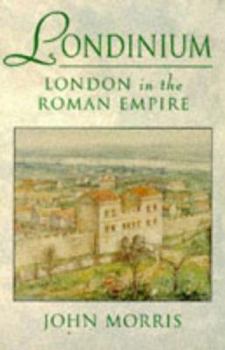Londinium : London in the Roman Empire
(Book #1 in the History of London Series)
Select Format
Select Condition 
Book Overview
At the time of the Roman invasion of Britain, the site of London was an untamed, uninhabited forest, and the victorious fleet founded Londinium, not as a garrison or a fortress, but as a centre of... This description may be from another edition of this product.
Format:Paperback
Language:English
ISBN:0753806606
ISBN13:9780753806609
Release Date:January 1999
Publisher:Orion Publishing Group, Limited
Weight:1.40 lbs.
Dimensions:11.9" x 1.2" x 6.1"
Customer Reviews
2 ratings
Good but dated history of Roman London
Published by Thriftbooks.com User , 19 years ago
For most historians, the greatest single limitation to understanding the past is the availability of source material. Ultimately, our ability to decipher what came before is limited by the records at hand, a factor which can constrain even the best historian. The limitation is particularly evident in John Morris' history of Roman London. A longtime historian of the Roman Empire and its aftermath in Britain, Morris draws upon the range of available archaeological and historical evidence to describe the first centuries of London's existence. With chapters on the development of the town, its governance, and the everyday habits of its inhabitants, he provides a good examination of life in Londinium and the role the city played in Rome's rule over Britain. Yet Morris' command of the material cannot mask its thinness. Most of the first part of the book is devoted to providing a history of pre-Roman and Roman Britain, which, while useful, often loses relevancy and can feel a little like padding. Moreover, the absence of detailed evidence often forces Morris to resort to supposition, or inference from other Roman cities. This does not make it a bad book, but the age of the text (originally written in the early 1970s and revised after Morris' death) does beg for updating as new archaeological and historical evidence emerges which allows us to improve and refine our understanding of London's earliest inhabitants. Until then, we have Morris' fine, if dated study.
A fascinating text
Published by Thriftbooks.com User , 21 years ago
'Londinium: London in the Roman Empire' by John Morris is an absolutely wonderful book on the history of London's origins. A narrative history that is thorough and interesting, this text covers a wide range of historical issues.Morris organises the book in three sections: The Making of London, Roman London, and The Survival of London. Apart from these three primary sections is an Introduction, notes, bibliography, and an index.Morris correctly identifies that prior to Rome, there was no London, and after Rome, not much is known about/heard of from London for hundreds of years. Therefore, to understand London, one must have at the very least a basic understanding of Rome -- Roman architecture, Roman social structures and hierarchy, Roman military and economic institutions, and Roman concerns. There are two primary sources for history that Morris uses, and uses well: archaeological and documentary. Acclaimed as a master of both types, as well as an innovative thinker and careful interpreter, Morris uses archaeology and documentary evidence in connection with each other in a more-or-less equal weighting. The drawback here is that there is precious little documentary evidence of London during the Roman period, as London was almost as far from the centre of the Empire as one could get while still being part of the Empire (a somewhat ironic position for London to be in, considering its position as the centre of another worldwide empire many centuries later). In looking at The Making of London, goes back to the very beginnings, looking not only at Rome, but even before Rome. Morris does a brief survey of pre-historic Britain, not great in detail, but important in giving a grounding of the ground on which London was built. London was not a 'natural' settlement -- it was placed by deliberate decision on the part of the powerful of Rome; like other major Roman provincial capitals (Paris, Vienna, Belgrade, Cologne), it grew to major proportions later in history; unlike these, it dominated the country it served much more completely. Morris continues his survey by looking at Rome before Caesar and then Flavian Rome, Britain of the Belgae and the Roman conquest, and the consolidation of Roman power under the Flavians.In the second section, Roman London, Morris examines the development of a mature Roman city. This includes important structures such as Government House, City Hall, the Forum, the baths and other public works, so that the people could pursue typical Roman pursuits such as education, economy, sporting events, and typical work any provincial trading centre would host. Locations for theatres and racecourse/stadiums in London are not known (unlike other towns such as Canterbury). To a certain extent, therefore, Roman life in London is based on an extrapolation of typical Roman life in any like-sized city in the northern Roman empire.In the third major section, The Survival of London, Morris looks at the 'fall' of Roman through the lens






